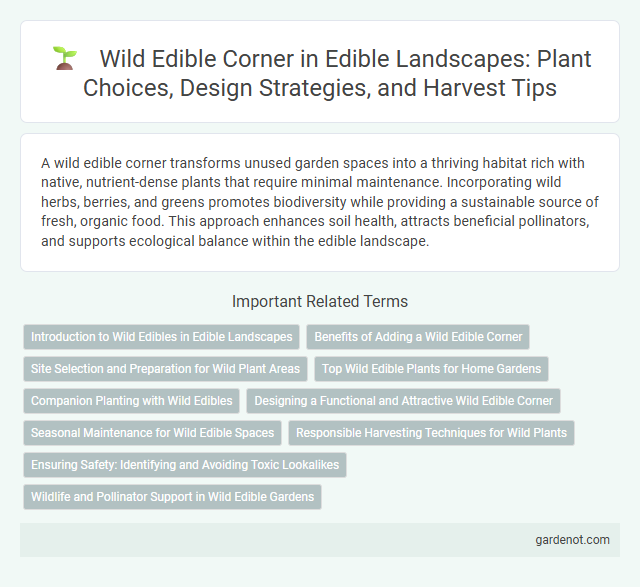A wild edible corner transforms unused garden spaces into a thriving habitat rich with native, nutrient-dense plants that require minimal maintenance. Incorporating wild herbs, berries, and greens promotes biodiversity while providing a sustainable source of fresh, organic food. This approach enhances soil health, attracts beneficial pollinators, and supports ecological balance within the edible landscape.
Introduction to Wild Edibles in Edible Landscapes
Wild edible corners transform garden spaces into abundant sources of nutritious, foraged foods such as dandelions, purslane, and wild garlic. These natural patches promote biodiversity while providing seasonal greens rich in vitamins and antioxidants. Incorporating wild edibles into edible landscapes enhances sustainability by reducing reliance on conventional crops and encouraging local ecosystems.
Benefits of Adding a Wild Edible Corner
Incorporating a wild edible corner into your garden enhances biodiversity by attracting pollinators and beneficial insects, promoting a healthier ecosystem. These native plants require minimal maintenance and water, making them a sustainable choice for food production. Harvesting wild edibles provides nutrient-rich, organic ingredients that support local wildlife and reduce reliance on commercial produce.
Site Selection and Preparation for Wild Plant Areas
Selecting a wild edible corner requires careful assessment of soil quality, sunlight exposure, and native plant presence to ensure optimal growth of wild edibles. Preparing the site involves minimal disturbance to existing ecosystems, using techniques such as mulching and natural soil amendments to promote biodiversity and soil health. Prioritizing native wild plants adapted to local conditions enhances sustainability and yields a thriving edible landscape.
Top Wild Edible Plants for Home Gardens
Top wild edible plants for home gardens include purslane, dandelion, and lamb's quarters, which offer high nutritional value and easy cultivation. These plants provide vitamins, antioxidants, and essential minerals while requiring minimal maintenance and thriving in various soil types. Incorporating wild edibles enhances biodiversity, supports pollinators, and promotes sustainable, organic gardening practices.
Companion Planting with Wild Edibles
Companion planting with wild edibles enhances biodiversity and pest control within an edible landscape by naturally attracting beneficial insects and deterring harmful pests. Integrating native wild herbs like yarrow, goldenrod, and wild garlic alongside vegetable crops improves soil health and promotes pollination efficiency. This synergistic planting method supports sustainable food production while maintaining ecological balance.
Designing a Functional and Attractive Wild Edible Corner
Designing a functional and attractive wild edible corner involves selecting native, nutrient-rich plants that thrive in local conditions, such as wild berries, herbs, and leafy greens. Incorporating layered planting techniques with ground covers, shrubs, and small trees maximizes space and encourages biodiversity while providing seasonal harvests. Strategic placement of pathways and signage enhances accessibility and aesthetic appeal, inviting exploration and sustainable foraging.
Seasonal Maintenance for Wild Edible Spaces
Seasonal maintenance for wild edible spaces involves pruning, mulching, and soil enrichment to support plant health and maximize yield throughout the year. Regularly removing invasive species and monitoring moisture levels ensure wild edibles thrive in changing seasonal conditions. Implementing crop rotation and companion planting techniques helps sustain biodiversity and enhances natural pest control in wild edible corners.
Responsible Harvesting Techniques for Wild Plants
Responsible harvesting techniques for wild plants in an edible landscape prioritize sustainability to maintain ecosystem health and plant populations. Selective harvesting methods involve gathering only mature leaves, fruits, or seeds while leaving enough to ensure natural regeneration and habitat for wildlife. Using minimal-impact tools and avoiding over-harvesting protect soil integrity and support biodiversity within the wild edible corner.
Ensuring Safety: Identifying and Avoiding Toxic Lookalikes
Accurately identifying wild edible plants in your garden is essential to prevent accidental ingestion of toxic lookalikes, which can resemble safe species in shape, color, or habitat. Employ thorough research using credible field guides and local expert consultations to distinguish edible varieties from harmful counterparts. Implement clear labeling and educate family members or visitors about potential risks to maintain a safe and thriving edible landscape environment.
Wildlife and Pollinator Support in Wild Edible Gardens
Wild edible gardens create vital habitats that support diverse wildlife, including native birds, insects, and small mammals, by providing natural food sources and shelter. These gardens enhance pollinator populations, such as bees, butterflies, and hummingbirds, through abundant flowering plants rich in nectar and pollen. Integrating wild edibles fosters ecosystem balance, promoting biodiversity and improving overall garden health.
Wild edible corner Infographic

 gardenot.com
gardenot.com